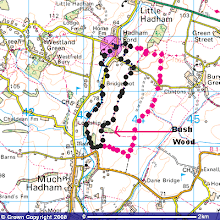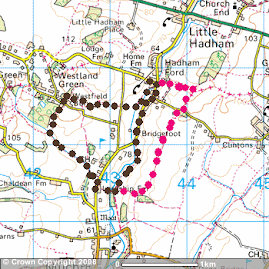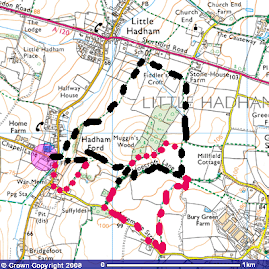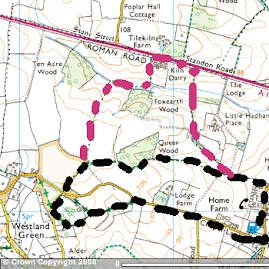Superb day. Last night I arrived too late to hire a bike so, after coffee and croissants this morning, I took the bus 20 miles North and walked back. The route was one I have done before, only in the other direction. Plenty of dragonflies near Paty de la Trinity where I got off the bus. Birds were spotted immediately, with beeaters, swallows, house and sand martins over the road and track. This track ran east for 4 miles and along here many rice fields. One was recently ploughed and very wet. 1000+ black headed gulls, 40+ glossy ibis, common sandpipers, lapwings, cattle and little egrets all feeding. Overhead, at least 40 kites, black and red but no hoped for short toed eagles. I stayed here a while before moving on whereupon I came across a spoonbill in the next field. Plenty of fan tailed warblers, spotless starlings, house sparrows and a blue butterfly: a holly blue, I suspect. After a while I turned south and headed for the edge of Etang de Vaccares, the largest lake in the Reserve. Here gulls and flamingoes along with a whimbrel, a new Camargue bird for me. Several purple herons rose from fields before I spotted another new bird for me here, a squacco heron. Excellent and close enough to get reasonable photos. The temperature was now at least 35C when I stopped for my lunch of beer and fruit. I was having to eek out my 2 litres of water. More of the same birds before I left the track on to the road for the last few miles back to town. Black winged stilts flew overhead along with an oystercatcher. Little egrets were everywhere. I stopped for a large beer at the first bar I encountered before finishing back at my room. 8 hours of walking and my arms and legs were getting a little red!. Few photos showing the path, Camargue horses, insects etc. I came across several marauding bull packs and had to change direction!! Photos on camera.
Sent using BlackBerry® from Orange
A record of the wildlife in and around Hadham Ford as from January 2008. Please feel free to leave any comments or email me with details of interesting bird, mammal, butterfly, moth and dragonfly sightings. @jonoForgham on twitter
Wednesday, 31 July 2013
Tuesday, 30 July 2013
Camargue Day 1
A flight from Luton at 6.20 meant leaving home at 3.30a.m. All went smoothly and I was on the bus to Nime before 10. From here, a bus to Arles and then another to Saintes Maries de la Mer meant I was in The Camargue by noon. From the bus to Ste Maries I saw glossy ibis, cattle egret, a harrier sp (probably montagues) black winged stilts and a solitary gull billed tern quatering fields as they do.
I found me room, dumped the ruckksack and went for lunch as I couldn't get into my room until 2. The town was busy so, after a steak, I changed and wandered along a new path for me. Common sandpipers, black headed gulls, sandwich terns and crested larks were common but in amongst all these were little egrets, slender billed gulls, little terns and more gull billed. All too distant for a photo but super to see. A cirl bunting called overhead, my first for the area. After following the path for 4 miles (in flipflops) I turned back, stopping to id dragonflies. Red veined darters were everywhere along with a few lesser emperors, and a blue bodied insect that I think is probably a scarce chaser, but not good enough views to confirm, yet. Sure there were other forms of darter, too. Spend more time on these tomorrow. Red veined shown below. Now, off for a meal and an early night. Also, plan to hire a push bike for the 27 mile ride to the reserve HQ at La Capeliere tomorrow. I hope to up and out early to avoid the heat. Today 33C and tomorrow is going to be hotter. Other photos: room view and a few distant flamingoes. All photos presently taken on phone. I shall add camera ones when I return.
Sent using BlackBerry® from Orange
I found me room, dumped the ruckksack and went for lunch as I couldn't get into my room until 2. The town was busy so, after a steak, I changed and wandered along a new path for me. Common sandpipers, black headed gulls, sandwich terns and crested larks were common but in amongst all these were little egrets, slender billed gulls, little terns and more gull billed. All too distant for a photo but super to see. A cirl bunting called overhead, my first for the area. After following the path for 4 miles (in flipflops) I turned back, stopping to id dragonflies. Red veined darters were everywhere along with a few lesser emperors, and a blue bodied insect that I think is probably a scarce chaser, but not good enough views to confirm, yet. Sure there were other forms of darter, too. Spend more time on these tomorrow. Red veined shown below. Now, off for a meal and an early night. Also, plan to hire a push bike for the 27 mile ride to the reserve HQ at La Capeliere tomorrow. I hope to up and out early to avoid the heat. Today 33C and tomorrow is going to be hotter. Other photos: room view and a few distant flamingoes. All photos presently taken on phone. I shall add camera ones when I return.
Sent using BlackBerry® from Orange
Saturday, 27 July 2013
Another year lister
A quiet evening at the trap, with a small waved umber being the only new moth for the year. Dot moth, cabbage moth, elephant hawk and regulars were present, but less than 50 macro moths in total. Plenty of wasps, though. Maybe having the trap under a plum tree is not the best place! Now have a new, portable generator so shall be out and about in local woods after a brief trip to The Camargue next week. Flying to Nimes early Tuesday morning, returning Friday afternoon. Hoping for some decent shots of short toed eagle, hoopoe, few warblers, black crowned night heron and hope to track down slender billed gull, gull billed tern and may even be an audouins gull, one of the rarest gulls in Europe..
 |
| rather worn small waved umber |
Friday, 26 July 2013
Village Wander
The temperature this afternoon prohibited my planned golf round so I took a wander around, firstly, Hadham Hall and then Millennium Wood.
Very few birds about, with house martins and swifts drinking at the lagoon. Several green woodpeckers and a large part of goldfinches (35+) along with a pair of tufted duck and a few reed buntings. A little grebe was noted on eggs, doing the usual thing of covering them with weed as she went off to feed. At the entrance to the hall is a dead tree, frequently a roosting spot for the local buzzard. He was there this afternoon. Over the lagoon were 2 emperor dragonflies, a single black tailed skimmer and a banded demoiselle damselfly. Several 1000 common blue damsels were over the water and breeding in the grass. Several common blue tailed damsels and some azure blues were also present.
Millennium Wood had a calling chiffchaff and singing blackbird but little else. A shaded broad bar moth was flushed and a few meadow browns, gatekeepers and small whites were present.
Very few birds about, with house martins and swifts drinking at the lagoon. Several green woodpeckers and a large part of goldfinches (35+) along with a pair of tufted duck and a few reed buntings. A little grebe was noted on eggs, doing the usual thing of covering them with weed as she went off to feed. At the entrance to the hall is a dead tree, frequently a roosting spot for the local buzzard. He was there this afternoon. Over the lagoon were 2 emperor dragonflies, a single black tailed skimmer and a banded demoiselle damselfly. Several 1000 common blue damsels were over the water and breeding in the grass. Several common blue tailed damsels and some azure blues were also present.
Millennium Wood had a calling chiffchaff and singing blackbird but little else. A shaded broad bar moth was flushed and a few meadow browns, gatekeepers and small whites were present.
 |
| pair of common blue damsels |
 |
| Just a few of the swarm of common blue damselflies |
 |
| peacock |
 |
| reed bunting |
 |
| little grebe |
 |
| common buzzard |
 |
| shaded broad bar |
 |
| gatekeeper. |
More Year listers
A good night last night, with 2 unusual moth records along with several expected species for the last week in July. A double lobed was only the 2nd garden record, whilst a marbled beauty was the 4th record. Also new for the year were lesser yellow underwing, magpie, dunbar and orange swift.
 |
| double lobed |
 |
| marbled beauty |
.JPG) |
| lesser yellow underwing |
Wednesday, 24 July 2013
Butterflies in Broxbourne Woods
After the Leavers' Assembly at a Hertford school to which I was invited, I popped up to Broxboune Woods. Usual suspects in good numbers: meadow browns, gatekeepers, large whites, commas, ringlets, a few peacocks and only one small tortoiseshell.
However, down the main ride, strangely no white admirals, but a few silver washed fritillaries, shown below ensuring another generation. Also, a few purple hairstreaks visible with the naked eye, enhanced with binoculars at the top of oaks. A quick search for purple emperors proved fruitless, but a good session, however. A brown and a migrant hawker also spotted as a few goldcrests called from the pines near the carpark and chiffchaffs did what it says on the tin.
However, down the main ride, strangely no white admirals, but a few silver washed fritillaries, shown below ensuring another generation. Also, a few purple hairstreaks visible with the naked eye, enhanced with binoculars at the top of oaks. A quick search for purple emperors proved fruitless, but a good session, however. A brown and a migrant hawker also spotted as a few goldcrests called from the pines near the carpark and chiffchaffs did what it says on the tin.
 |
| pair of silver washed fritillaries |
 |
| same pair |
 |
| same pair again |
 |
| silver washed fritillary |
 |
| swf |
 |
| ringlet |
new year listers in moth department
A good haul of regular moths augmented by several dingy footman and 2 ruby tigers, both of which were new for the garden this year
Other good 'uns were a presumed red twin spot carpet, shown above along with a very worn emerald species, suspected common. All in all a colourful night's trapping.
 |
| ruby tiger |
 |
| dingy skipper |
 |
| red twin spot carpet |
 |
| very worn common emerald |
 |
| ruby tiger |
Tuesday, 23 July 2013
Moth round up
Due to no outstanding moths of late there has been little to report, until this morning, when a small scallop was a new moth for my parish records whilst a bird's wing moth was only the 2nd garden record. Also of note, over the last 2 nights at least one pine hawkmoth has been taken, the first for the year.
A continual thunder storm last night and, as shown, a bright moon limited the catch. More of the same weather forecast for tonight. Also, amongst the many micros, a carcina quercana and pandemis corylana were notable. Common moths, but easily identifiable and colourful
A continual thunder storm last night and, as shown, a bright moon limited the catch. More of the same weather forecast for tonight. Also, amongst the many micros, a carcina quercana and pandemis corylana were notable. Common moths, but easily identifiable and colourful
 |
| bird's wing |
 |
| carcina quercana |
 |
| full moon |
Friday, 19 July 2013
Excellent moth record
An early visit to the moth trap looked to be just a job of noting regulars: small magpie, double square spot, heart and dart, clouded border, yellowtail, rustics, privet hawk, poplar hawk, peppered moth etc but things got better. A 2nd garden record of lilac beauty was pleasing, as was the first record of purple thorn this year but the highlight was undoubtedly a female oak eggar. This is an uncommon moth at light traps and my 1st record for the parish. Very pleasing and certainly worth the early visit. Reckon this might have been around for a couple of days, as a large moth crashed around on Wednesday night but didn't stop at the trap and was too fast to net.
 |
| female oak eggar |
 |
| oak eggar, close up |
 |
| purple thorn |
 |
| oak eggar |
Thursday, 18 July 2013
Hold the front page
Today, I received a photo taken by a resident of a moth from their home. Blurred and without any scale I couldn't confirm identification by email, so requested Helen kept it. So she did and my original identification thought was correct as I popped around this evening to collect the specimen. A male orange moth. This is a locally recorded moth within Hertfordshire with, between 1884 and 2006 only 10 records. The last most updated record was in 2003 in Bishop's Stortford and historically, the records show the moth was present in the late 19th century in the south of the county. A moth that has a selection of larval foodplants, including hawthorn, blackthorn, birches, heather, broom and honeysuckle. Clearly it prefers deciduous woodland and open rides and is only found around clay soils. All fairly good for Little Hadham, so strange it is not taken at traps more often.
Anyway, thanks to Helen and Paul for their sharp eyed behaviour and enthusiasm to contact me. A good record for the county. A phone photo here. I shall take better tomorrow in natural light. Record has been forwarded to several (now jealous) county moth-ers as well as the county recorder. Being a male, its main job of breeding will have been done so I suspect there will be several local moth-ers wishing to add it to their collection. Note; something I do not do. However, this moth was found naturally dead so not great issues with it being added to a Hertfordshire collection for archive and museum use for the future.
Anyway, thanks to Helen and Paul for their sharp eyed behaviour and enthusiasm to contact me. A good record for the county. A phone photo here. I shall take better tomorrow in natural light. Record has been forwarded to several (now jealous) county moth-ers as well as the county recorder. Being a male, its main job of breeding will have been done so I suspect there will be several local moth-ers wishing to add it to their collection. Note; something I do not do. However, this moth was found naturally dead so not great issues with it being added to a Hertfordshire collection for archive and museum use for the future.
 |
| orange moth |
Wednesday night mothing
After the previous night's extravaganza, I was relatively pleased to discover the temperature had been cooler during the night, consequently not so much moth activity. However, a small blood vein and single dot wave were new for the year, taking the year lister total to 130 macro moth species. Still some 20% below last years, but, courtesy of the warmer weather, a good haul of 28 year listers since Monday has meant a catch up on last year's total. However, it must be noted that some moths just didn't appear in spring and it will be interesting to see if they reappear next year in any numbers.
 |
| small blood vein |
.JPG) |
| single dot wave |
 |
| engrailled |
 |
| large yellow underwing |
 |
| Anania coronata |
Marathon Moth night
On Tuesday night the temperatures around 10pm were most conducive to mothing, so I decided to attend to the trap until the early hours. Consequently, I was potting moths, identifying them and then releasing them (away from the trap) until 3 in the morning. In all I trapped 57 species of macro moth with over 250 macros visiting the trap. A most hectic and busy night, that gave me 10 new species for the year and 2 new species for the garden. Well worth the effort. The new moths were a large twin spot carpet and a foxglove pug whilst the year listers were: white satin, small yellow wave, common white wave, yellowtail, yellowshell, browntail, July highflier, turnip moth, dark barred twin spot carpet and engrailled. I began identifying the micro moths but was just overcome by the quantity. Over 200 micros were apparent: Agapeta hamana, Spininota ocellana, Plueroptya ruralis, Choristoneura hebenstreilla, Crambus lathoniellus, Pandemis ceresana, Notocleia uddmanniana, green oak tortrix and white plume moth. Many more tortrix and pyralids were present, I just didn't have enough pots to pop them into to identify!
I would estimate a minimum of 450 moths from 10pm to 3 a.m. and then I returned to the trap before 6a.m. to empty it. Another 3 hours identifying, with some having to be fridged to slow them down. All were released alive. A most successful night.
 |
| engrailled |
 |
| white satin |
 |
| Large twin spot carpet |
 |
| Just part of the sheet next to the light trap! |
 |
| small yellow wave. |
 |
| Foxglove pug |
Subscribe to:
Comments (Atom)
This is me

At the end of another Norfolk Coastal footpath walk. 47 miles, 3 days 99 species of bird. September 2009
Caley Wood view

sunshine through the canopy 29.05.08
A walk along the Warta Valley, Poznan, Poland. Feb 2007
Best birds on this walk: black and middle spotted woodpecker and short toed treecreeper
About Me

- Jono Forgham
- A primary school teacher for 30 years, I retired from teaching in July 2009 to set up my own science enhancement and communication company. The Primary Works offers science clubs, workshops and staged science shows nationwide. I have always been interested in bird watching since my early years. Apparently my first tick was after inquiring about a chaffinch and then receiving the Observer book of birds. By the age of 9 I had moved on to Tory Peterson's collins guide and was now involved on YOC birding holidays to Northumbria, Essex coast, Slimbridge and Yorkshire. My twitching rule is that I will willingly travel 1km for each gram the bird weighs. However, I have had many rarities just by being in the right place. I have travelled widely throughout Europe and also visited Australia and Sri Lanka. In 2016 I spent time at Portland Bird Obs and two trips to Aviero, Portugal. 2017 found me back in Sri Lanka in Feb/March, then July and back for New Year's Eve celebrations in December. Also returned to The Camargue in May for a 4 day trip. Few plans for 2018, but nothing yet booked apart from a trip to the IOW.
Grey heron

Over the allotment 28.09.08
Southern Hawker

Ridge footpath 27.08.08
Juvenile green woodpecker (17.08.08)

Note the stripes, denoting a bird fledged this year.
common blue

Ash Valley G.C. 15.08.08
Indian balsam (impatiens glandulifera)

River Ash
azure damselfly

River Ash 28.07.08
marbled white

Discovered at Westland Green 22.07.08
ruddy darter

Bush Wood 21.07.08
honeysuckle 19.07.08

growing in hedgerow in Chapel Lane
cinnabar moth caterpillar

Photographed on ragwort 19.07.08
Bittersweet

Study of petals 11.06.08
male yellowhammer

08.06.08
common blue butterfly

06.06.08
River Ash

looking south from the bridge at Hadham Ford
Common poppy (papaver rhoeas)

in rape field 29.05.08
Caley Wood sunshine

29.05.08
Millenium Wood fox

24.05.08
common comfrey (symphytum officinale)

06.05.08 banks of the River Ash
Garlic Mustard or Jack by the Hedge,(Alliara petiolata)

flowers, leaves and fruit edible . Good in salad and pesto
April showers

Double rainbow 30.04.08
Caley Wood bluebells

22.04.08
Yellow Archangel

Chapel Lane (20.04.08)
sunlight 16.04.08

looking south west from Bush Wood
snowy buds

06.04.08 in Bush Wood
Looking north west

05.04.08 evening shower approaching
Back Garden

Easter Sunday (23.03.08)
Brick Kiln Hill

Looking east (23.03.08)
No play today

The 2nd hole at Ash Valley golf course
Teasel head

Bush Wood (21.03.08)
Reflections

daffodils at Bush Wood pond (21.03.08)
Swollen River Ash

The river at the bottom of Winding Hill 16.03.08
Daybreak over the chapel

Thursday 13th March
Wild daffodils (narcissus pseudonarcissus)

growing in Bush Wood
January snowdrops

Banks of River Ash, north of Much Hadham
Good Moon

From garden 24.01.08
Village Green

Looking east towards Acremore Street
Looking south before Hadham Ford

rare January blue sky
Useful sites
The following are some useful websites that may interest readers of this blog.
Firstly, Bishop's Stortford Natural History Society http://bsnhs.webplus.net/
Firstly, Bishop's Stortford Natural History Society http://bsnhs.webplus.net/
Fellow birder, Gary Whelan's blog. Gives reports from our trips out together plus reports from his trips abroad. http://hairybirders.blogspot.co.uk
http://www.hertsbirdclub.org.uk/ The official herts bird club website. Frequently updated, listing bird sightings around the county. Offers links to many other websites. Both of these sites also offer links to yahoo discussion groups.
http://www.birdforum.net/ An international site. You can enter as a guest but become a member( free) to post comments, bird sightings and just about anything to do with wild birds. Good news updates, classified section for binoculars, cameras etc.
http://www.guidedbirdwatching.com/ A new site set up where you can contact people worldwide who will help you find good birds in their country. UK section being set up presently.
http://www.britainsbirder.co.uk/
Fellow birders blog. Strtford resident, Graeme Smith regulary birds the area south of Stortford as well as around Spellbrook and the River Stort from Spellbrook to Twyford Locks. Some superb bird photography: Graeme uses a digital camera attached to his powerful telescope to get detailled images of the birds he sees. Well worth a browse.
Two local sites that may be of interest can be found at
http://www.thehadhams.com/ www.thepelhams.net/content/section/12/139/
http://www.hertsbirdclub.org.uk/ The official herts bird club website. Frequently updated, listing bird sightings around the county. Offers links to many other websites. Both of these sites also offer links to yahoo discussion groups.
http://www.birdforum.net/ An international site. You can enter as a guest but become a member( free) to post comments, bird sightings and just about anything to do with wild birds. Good news updates, classified section for binoculars, cameras etc.
http://www.guidedbirdwatching.com/ A new site set up where you can contact people worldwide who will help you find good birds in their country. UK section being set up presently.
http://www.britainsbirder.co.uk/
Fellow birders blog. Strtford resident, Graeme Smith regulary birds the area south of Stortford as well as around Spellbrook and the River Stort from Spellbrook to Twyford Locks. Some superb bird photography: Graeme uses a digital camera attached to his powerful telescope to get detailled images of the birds he sees. Well worth a browse.
Two local sites that may be of interest can be found at
http://www.thehadhams.com/ www.thepelhams.net/content/section/12/139/
South Easterly walk

black, normal, red extended walk
South Westerly route.

Black usual, red extended
North Easterly walk

black short, walk. Red, extended
North West Patch

black route regular. Red route the extended wander









